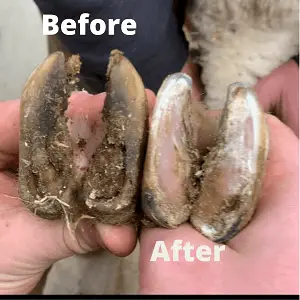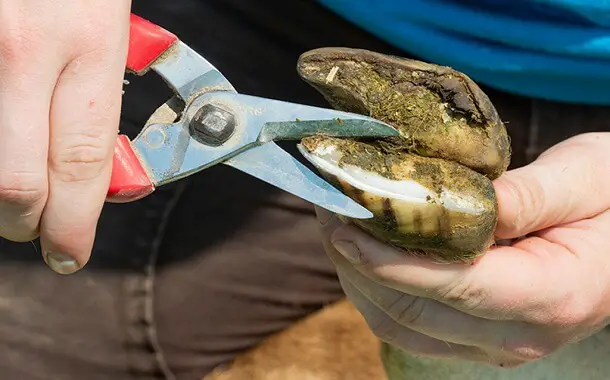How Much Does It Cost to Trim Goat Hooves?
Last Updated on February 7, 2024
Written by CPA Alec Pow | Content Reviewed by ![]() CFA Alexander Popinker
CFA Alexander Popinker
Keeping your goats’ hooves healthy and properly maintained is essential for their welfare and productivity. But hoof care can also be a significant expense for goat owners.
In this article, we’ll look at the average costs of goat hoof trimming and what impacts the pricing for both professional hoof trimming services and DIY options.
How Much Does It Cost to Trim Goat Hooves?
So, what does it typically cost to have your goats’ hooves trimmed? Prices can range quite a bit, but here are some general guidelines:
- Professional farm call trimming service: $10-$20 per goat
- Mobile professional trimming: $7-$15 per goat
- DIY hoof trimming: $2-$5 per goat (after initial tool purchase)
The national average cost is around $15 per goat for a professional hoof trim. But there are several factors that cause costs to vary.
Depending on the trimmer and the size of the job, according to Goat Owner, the cost of trimming goat hooves should be somewhere from $8-$20 per goat.
An average cost is around $20 per goat for large goats with formidable hooves that will take a lot of trimming. However, diminutive pygmy goats will cost a fraction of that to trim.
The reported prices from Dairy Goat Info for trimming goat hooves range from $5 to $15 per goat, depending on the specific service provider and the location.
Raven’s View Farms notes that the cost of trimming goat hooves is $15 per animal.
Why Regular Goat Hoof Trimming Is Important
Goats’ hooves continuously grow, much like our fingernails. Without proper maintenance, the hooves can become overgrown, misshapen, and prone to cracking. Overgrown hooves put pressure on the soft inner structures of the hoof, causing pain and difficulty walking.
Neglected hooves also allow bacteria and fungi to enter through cracks in the outer wall. This can lead to infections like hoof rot, a highly contagious bacterial disease.
Regular trimming every 4-8 weeks removes excess hoof growth and allows you to identify and address any emerging problems. Keeping your goats’ hooves well-maintained through routine hoof care is essential to their comfort, mobility, and health.
Goat Hoof Trimming Explained
Trimming goat hooves involves carefully clipping and filing the hooves to restore proper shape and function. The goal is to leave a flat weight-bearing surface while removing any overgrown portions.
Proper trimming improves traction, realigns the bones into proper position, and minimizes stress on the legs and feet. It also gives you a chance to clean and treat any infections.
Trimming is generally done with specialized hoof trimming shears, a hoof knife, and a rasp. Proper restraint is necessary to keep the animal still and avoid injury. Sedation may be used in some cases.
Goats with overgrown but otherwise healthy hooves only need maintenance trimming every couple of months. Goats with hoof infections or deformities may need more frequent trimming.
Factors Influencing Goat Hoof Trimming Costs
Some things that impact the price of goat hoof trimming include:
- Location – Prices tend to be higher in urban and suburban areas than rural regions.
- Individual vs. herd service – Trimming a whole herd at once is more efficient and may have discounted rates.
- Farm call vs. drop off – On-farm service costs more than dropping off at a facility.
- Extra services – Medicating infections, hoof reconstructive work, and sedation add to the base cost.
- Hoof health – Severely overgrown or infected hooves take more time and skill to trim.
- Goat temperament – Difficult or unruly goats may warrant a higher service fee.
- Travel fees – For mobile trimming, travel time and distance increase the price.
DIY Hoof Trimming vs Professional Service
DIY hoof care allows goat owners to save on service costs by trimming their herd’s hooves themselves. But it requires obtaining proper hoof trimming equipment, learning proper technique, and taking the time to trim each goat.
There’s also an increased safety risk to both the goats and handler with inexperienced trimming. However, DIY may be a good option for owners with just a few goats.
You might also like our articles on the cost of goats in general, fainting goats, and pygmy goats.
Professional hoof trimming requires minimal effort by the owner. You also benefit from an experienced trimmer who can properly identify and address any hoof problems.
The service cost is higher. But for larger herds or owners who prefer not to do it themselves, professional trimming is worth the price.
What to Expect During Professional Trimming
 When you hire a professional goat hoof trimmer, here’s what you can expect:
When you hire a professional goat hoof trimmer, here’s what you can expect:
- Evaluation of overall hoof health for the herd and any trimming needs
- Proper restraint of each goat to safely trim the hooves
- Removal of excess growth with specialized hoof shears and knife
- Filing and leveling the hooves using a rasp
- Treating any infections by cleaning and applying medication
- Inspecting for issues like hoof rot, abscesses, and laminitis
- Discussing any issues or special needs observed with the owner
- Demonstrating proper technique if owner wishes to learn
The actual trimming process takes about 2-5 minutes per goat. Larger herds may take several hours to work through all the goats.
Tips for DIY Goat Hoof Trimming
Here are some tips if you choose to trim your herd’s hooves yourself:
- Invest in proper hoof trimming shears, knives, files, and a quality hoof stand. Expect to spend $75-$150 to get equipped.
- Study hoof anatomy and watch videos to learn proper trimming techniques before attempting it.
- Have an experienced person coach you the first few times before trying it solo.
- Go slow and don’t cut too much at first. Only trim what is clearly excess growth.
- Restrain animals safely and calmly. Enlist an assistant if needed.
- Inspect hooves closely and treat any problems seen, or have a vet do so.
- Keep tools sharpened. Dull tools make the job harder and risk cracking the hooves.
Maintaining Hooves Between Trims
To minimize overgrowth between trims:
- Check hooves weekly for any cracks, chips, or abnormal wear. Address any issues promptly.
- Provide a clean, dry housing area without sharp rocks or rough surfaces.
- Avoid wet or muddy ground that could soften hooves. Use gravel or concrete pathways.
- Feed a balanced diet with proper calcium and minerals for hoof health. Consider a biotin supplement.
- Control contagious hoof infections through quarantine and disinfecting. Isolate infected animals.
Staying vigilant in between professional trims or DIY sessions will help keep your herd’s hooves healthy.
Final Words
Regular hoof care is essential for goat health and requires ongoing time and financial commitment. But paying attention to hooves pays dividends through improved mobility, production, and welfare.
Costs for goat hoof trimming average $15 per goat but can vary from $7-$20 based on your location and service options. Evaluate your own setup and needs to decide whether DIY or hiring a professional makes the most sense.
With some diligence about periodic trimming and prompt attention to any problems, you can keep your herd’s hooves in great shape. Healthy hooves make for happy, thriving goats.
Frequently Asked Questions
How often should I have my goats’ hooves trimmed?
For goats with healthy hooves, trimming every 6-8 weeks is recommended. More frequent trimming may be needed for goats with hoof problems or rapid growth. Have a professional evaluate your herd and make recommendations on optimal trimming frequency.
How can I find a qualified professional hoof trimmer in my area?
Ask other local goat owners for recommendations. Check with your veterinarian, state livestock associations, agricultural extension office, or 4H groups for referrals. Ensure any farrier has specific training and experience with goats, as their hooves differ from horses.
Is it better to trim goats’ hooves when they are dry or wet?
Trimming when hooves are dry makes it easier to evaluate their true shape and identify any irregularities. The outer wall is also more rigid when dry, reducing the risk of cracking during trimming. If hooves are wet, thoroughly dry them before trimming for best results.



Leave a Reply
Want to join the discussion?Feel free to contribute!